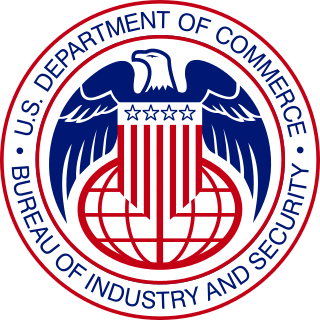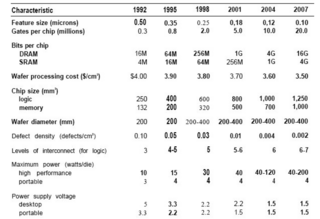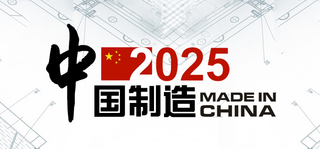
The Bureau of Industry and Security (BIS) is an agency of the United States Department of Commerce that deals with issues involving national security and high technology. A principal goal for the bureau is helping stop the proliferation of weapons of mass destruction, while furthering the growth of United States exports. The Bureau is led by the Under Secretary of Commerce for Industry and Security.

Taiwan Semiconductor Manufacturing Company Limited is a Taiwanese multinational semiconductor contract manufacturing and design company. It is the world's most valuable semiconductor company, the world's largest dedicated independent (pure-play) semiconductor foundry, and one of Taiwan's largest companies, with its headquarters and main operations located in the Hsinchu Science Park in Hsinchu. It is majority owned by foreign investors.

The arms industry, also known as the defence industry, the defense industry, the military industry, or the arms trade, is a global industry which manufactures and sells weapons and military technology. Public sector and private sector firms conduct research and development, engineering, production, and servicing of military material, equipment, and facilities. Customers are the armed forces of states, and civilians. An arsenal is a place where arms and ammunition – whether privately or publicly owned – are made, maintained and repaired, stored, or issued, in any combination. Products of the arms industry include weapons, munitions, weapons platforms, military communications and other electronics, and more. The arms industry also provides other logistical and operational support.
International Traffic in Arms Regulations (ITAR) is a United States regulatory regime to restrict and control the export of defense and military related technologies to safeguard U.S. national security and further U.S. foreign policy objectives.

The export of cryptography from the United States to other countries has experienced various levels of restrictions over time. World War II illustrated that code-breaking and cryptography can play an integral part in national security and the ability to prosecute war. Changes in technology and the preservation of free speech have been competing factors in the regulation and constraint of cryptographic technologies for export.

In politics, diplomacy and export control, dual-use items refers to goods, software and technology that can be used for both civilian and military applications.

Semiconductor Manufacturing International Corporation (SMIC) is a partially state-owned publicly listed Chinese pure-play semiconductor foundry company. It is the largest contract chip maker in mainland China.

The Semiconductor Industry Association (SIA) is a trade association and lobbying group founded in 1977 that represents the United States semiconductor industry. It is located in Washington, D.C.
GlobalFoundries Inc. is a multinational semiconductor contract manufacturing and design company incorporated in the Cayman Islands and headquartered in Malta, New York. Created by the divestiture of the manufacturing arm of AMD, the company was privately owned by Mubadala Investment Company, the sovereign wealth fund of the United Arab Emirates, until an initial public offering (IPO) in October 2021.

Made in China 2025 is a national strategic plan and industrial policy of the Chinese Communist Party (CCP) to further develop the manufacturing sector of China, issued by CCP general secretary Xi Jinping and Chinese Premier Li Keqiang's cabinet in May 2015. As part of the Thirteenth and Fourteenth Five-year Plans, China aims to move away from being the "world's factory"—a producer of cheap low-tech goods facilitated by lower labour costs and supply chain advantages. The industrial policy aims to upgrade the manufacturing capabilities of Chinese industries, growing from labor-intensive workshops into a more technology-intensive powerhouse.
The Indian electronics industry saw growth in the early years of the 21st century, encouraged both by government policies and incentives and by international investment. Its key and most resource-intensive segment, the semiconductor industry benefitted from domestic demand growing briskly. Semiconductors were required by a large number of industries, including telecommunications, information technology, industrial machinery and automation, medical electronics, automobile, engineering, power and solar photovoltaic, defense and aerospace, consumer electronics, and appliances. As of 2015, however, the skill gap in the Indian industry threatened progress, with 65 to 70 percent of the market relying on imports.
The AMD–Chinese joint venture is the agreement between the American semiconductor company Advanced Micro Devices (AMD) and China-based partners to license and build x86-compatible CPUs for the Chinese-based market. China has been unable to produce a CPU on based its own technology; This is significant because the joint venture was negotiated and agreed to well before the 2018 trade war between the US and China and the international chip shortage of the early 2020's. Unlike Taiwan, China does not have an established or lucrative microchip industry or even capabilities for that matter. It is similar to the Zhaoxin joint venture supported by VIA Technologies. Unlike other industries in which China naturally excel at, the microchip industry requires significant research and development.
The United States government applies sanctions against certain institutions and key members of the Chinese government and its ruling Chinese Communist Party (CCP), certain companies linked to the People's Liberation Army (PLA), and other affiliates that the US government has accused of aiding in human rights abuses. The US maintained embargoes against China from the inception of the People's Republic of China in 1949 until 1972. An embargo was reimposed by the US following the 1989 Tiananmen Square protests and massacre. From 2020 onward, the US imposed sanctions and visa restrictions against several Chinese government officials and companies, in response to allegations of a genocide against the Uyghur population in Xinjiang and human rights abuses in Hong Kong and Tibet.
The Entity List is a trade restriction list published by the United States Department of Commerce's Bureau of Industry and Security (BIS), consisting of certain foreign persons, entities, or governments. Entities on the Entity List are subject to U.S. license requirements for the export or transfer of specified items, such as some U.S. technologies. However, U.S. persons or companies are not prohibited from purchasing items from a company on the Entity List. Being included on the Entities List is less severe than being designated a "Denied Person" and more severe than being placed on the Unverified List (UVL).
The Taiwanese semiconductor industry, including IC manufacturing, design, and packing, forms a major part of Taiwan's IT industry. Due to its strong capabilities in OEM wafer manufacturing and a complete industry supply chain, Taiwan has been able to distinguish itself from its competitors and dominate the global marketplace. Taiwan semiconductor sector accounted for US$115 billion, which is ca. 20% of global semiconductor industry. In selected sectors like foundry operations, Taiwanese companies account for 50% of world market, with Taiwan Semiconductor Manufacturing Company (TSMC) being the biggest player in the foundry market.

The 2020–present global chip shortage is an ongoing global crisis in which the demand for integrated circuits exceeds the supply, affecting more than 169 industries. The crisis has led to major price increases, shortages queues and reselling among consumers and manufacturers for automobiles, graphics cards, video game consoles, computers, household appliances, and other electronic products that require semiconductors.

The Artificial Intelligence Cold War is a narrative in which tensions between the US and China lead to a second Cold War waged in the area of AI technology rather than in the areas of nuclear capabilities or ideology. The context of the AI Cold War narrative is the AI Arms Race, which involves a build-up of military capabilities using AI technology by the US and China. A key area of concern in the tensions between China and the US are semiconductors because of their key role of semiconductors for the competitiveness of the AI industry.
The Chinese semiconductor industry, including IC design and manufacturing, forms a major part of mainland China's IT industry.

The CHIPS and Science Act is a U.S. federal statute enacted by the 117th United States Congress and signed into law by President Joe Biden on August 9, 2022. The act provides roughly $280 billion in new funding to boost domestic research and manufacturing of semiconductors in the United States. The act channels more than $52 billion into researching semiconductors and other scientific research, with the primary aim of countering China. Chip suppliers have committed or made announcements totally over $300 billion in investments and jobs in anticipation of the passing of the act.
Shanghai Biren Intelligent Technology Co. is a Chinese fabless semiconductor design company. The company was founded in 2019 by Lingjie Xu and others, all of whom were previously employed at NVIDIA or Alibaba. Biren has advertised two general-purpose graphics processing units (GPGPUs), the BR100 and BR104. Both cards are aimed at artificial intelligence and high-performance computing.









